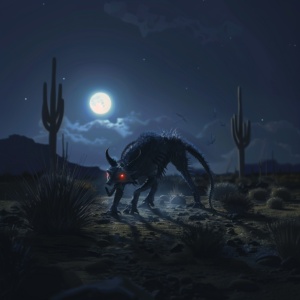In a small rural community in southern Texas, recent reports of a Chupacabra sighting have reignited interest in one of the most notorious cryptids of modern folklore. The creature, known for its supposed blood-sucking tendencies and eerie appearance, was allegedly spotted by a local resident just after sunset, sending shockwaves through the otherwise quiet town.

Maria Hernandez, a long-time resident of the area, described her encounter with what she believes was a Chupacabra. “I was out feeding the chickens when I noticed something strange moving near the treeline,” Hernandez recalled. “It was unlike any animal I’ve ever seen. It was hairless, with spines along its back and glowing red eyes. When it looked at me, I felt a chill run down my spine. Then, it let out this high-pitched screech and darted into the woods.”
Hernandez’s account echoes the traditional descriptions of the Chupacabra, a creature whose name translates from Spanish to “goat-sucker.” The legend of the Chupacabra first emerged in Puerto Rico during the mid-1990s, where it was blamed for a series of mysterious livestock deaths. Farmers reported finding their goats, chickens, and other animals drained of blood, with puncture wounds on their necks. The reports quickly spread throughout Latin America and even into parts of the United States, with each sighting contributing to the creature’s growing mythos.
Over the years, the Chupacabra has been described in various ways. In some accounts, it appears as a reptilian creature with spines running down its back and large, alien-like eyes. In other reports, it resembles a strange, hairless dog or coyote, often in poor health or suffering from mange, a skin disease that can cause significant hair loss and a feral appearance. Despite the varying descriptions, the common thread in all Chupacabra stories is its vampiric behavior, preying on livestock and leaving behind a grisly scene.
Skeptics often dismiss Chupacabra sightings as cases of mistaken identity, attributing the phenomenon to wild animals like coyotes, dogs, or raccoons suffering from mange. The lack of concrete evidence, such as clear photographs, physical remains, or biological samples, has fueled doubts about the creature’s existence. Nevertheless, the legend persists, driven by the fear and fascination that the Chupacabra evokes.
The recent sighting in Texas has left the local community divided. Some residents, like Hernandez, are convinced that the Chupacabra is real and may be responsible for the occasional livestock deaths in the area. “We’ve lost a few chickens over the years, and I always thought it was just wild animals. But after seeing that creature, I’m not so sure anymore,” she said.
Local authorities, while taking the reports seriously, have urged residents to remain calm and exercise caution. “We haven’t found any evidence to suggest that there’s a dangerous animal on the loose,” said Sheriff Tom Walters. “But we’re advising people to keep their pets and livestock secure and to report any unusual sightings or behavior.”
As with many cryptids, the Chupacabra occupies a unique place in the cultural landscape—a creature born out of fear and the unknown. Whether the Chupacabra is a real animal, a misidentified known species, or simply a product of folklore, the impact of its legend is undeniable. The sighting in Texas is just the latest chapter in a story that has captivated imaginations for nearly three decades, reminding us that the line between myth and reality can sometimes be very thin.
For now, the residents of this small Texas town will be keeping a watchful eye on the treeline, wondering if the mysterious creature that Hernandez saw will make another appearance. Until then, the legend of the Chupacabra lives on, fueled by sightings like these and the stories that continue to be told.
